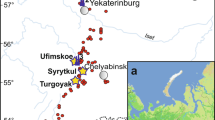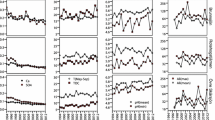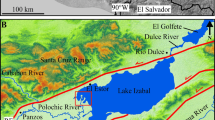Abstract
Studies are reported on two small lakes at Sudbury, Ontario located close to a nickel-copper smelter which closed in 1972. At that stage, Baby Lake had a pH of 4.0–4.2 while the adjacent Alice Lake had a pH 5.9–6.3. Both lakes were almost entirely devoid of algae and had neither Zooplankton nor fish. Soon after the closure of the smelter, with its large airborne volume of sulphur dioxide and of copper and nickel containing particulates, the chemistry of the lakes began to change. By 1985, Baby Lake had changed from pH 4.0 to 6.8 and is now at pH 7.2. The pH of Alice Lake increased from a low of 5.9 in the early 1970s to 6.9–7.4 in the mid 1980s and is now at 7.3. Copper and nickel concentrations also decreased in both lakes during this period. The first biota found in the lakes in the post-smelter stage in the early 1980s were benthic red chironomids, planktonic rotifers, and a limited number of phytoplankton species, of which Rhizosolenia was the most common. By the 1990s, 13 phytoplankton species were present in each lake, with a substantial Zooplankton fauna (14 species) of rotifers, copepods, and cladocerans. There are now numerous insect larvae in the sediment and some small fish in both lakes. The biological recovery, which followed substantial reductions in acidity and in soluble nickel and copper concentrations in the waters, is a slower process than chemical recovery and is initially characterized by the dominance of a few species.
Similar content being viewed by others
References
Brydges, T. 1985. pers. comm., Atmospheric Environment Serivce, Toronto, Canada.
Deniseger, J., A., Austin, M., Roch, and M.J.R., Clark: 1986. Environmental & Experimental Botany 26 (3), 217.
Freedman, B. and T. C., Hutchinson: 1980, Canadian Journal of Botany 58, 2123.
Havas, M. and G.E., Likens. 1985. Canadian Journal of Zoology 63, 1114.
Hutchinson, T.C. and M., Havas: 1986, Water, Air and Soil Pollution 28, 319.
Hutchinson, T.C. and P.M., Stokes: 1975, Metal Toxicity and Algal Bioassays, Water Quality Parameters, American Soc. for Testing and Materials, Philadelphia, pp. 320–343.
Hutchinson, T.C. and L.M., Whitby: 1974, Environmental Conservation 1, 123.
Keller, W., J.M., Gunn, and N.D., Yan: 1992, Environmental Pollution 78, 79.
MacIsaac, H.J., W., Keller, T.C., Hutchinson, and N.D., Yan: 1986, Water, Air and Soil Pollution 31, 791.
Stokes, P.M. and T.C., Hutchinson, and K., Krauter: 1973, Canadian Journal of Botany 51, 2155.
Whitby, L.M. and T.C., Hutchinson: 1974, Environmental Conservation 1, 421.
Woodfine, D.G. and M. Havas: 1995, Water, Air and Soil Pollution (this volume).
Author information
Authors and Affiliations
Rights and permissions
About this article
Cite this article
Havas, M., Woodfine, D.G., Lutz, P. et al. Biological recovery of two previously acidified, metal-contaminated lakes near Sudbury Ontario, Canada. Water Air Soil Pollut 85, 791–796 (1995). https://doi.org/10.1007/BF00476926
Issue Date:
DOI: https://doi.org/10.1007/BF00476926




